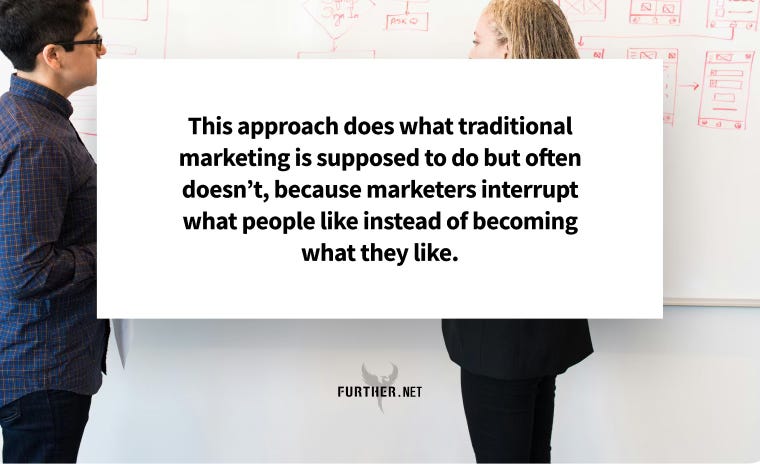Media, Not Marketing: The Brand Strategy that Attracts Your Ideal Audience
A smarter marketing strategy than what most people consider marketing.
At the root of a successful personal enterprise is your audience. That’s an engaged group of people who look to you for guidance, recommendations, and services.
They do so because they’ve come to know, like, and trust you.
This is what traditional marketing is supposed to do but often doesn’t, because many marketers interrupt what people like instead of becoming what they like. And that’s even with big budgets that freelancers, consultants, and bootstrapped entrepreneurs can’t afford when starting out.
A different approach has emerged over the last two decades due to the unique aspects of the internet and digital media. It dates back to the early days of email newsletters and blogging. And it now has a fairly long track record as the way to build progressive wealth and influence over time.
I call it media, not marketing. You attract an online audience thanks to the same reasons people read trade and general business magazines, watch educational television, and read non-fiction books — to obtain valuable knowledge and advice.
This is commonly called content marketing, which is a term that doesn’t really convey the media aspect of it. Many marketers still think it means slapping up mediocre articles on the company “brochure” site to please the Google gods.
The term mentor marketing gets us closer. It’s all about how a media format empowers you to effectively mentor your audience without making them feel “sold” to. This model encourages your audience to help grow itself through social sharing and other forms of recommendations to friends and colleagues.
Here’s one of my favorite examples to explain content marketing for service businesses to people who have no idea what it means. This example is a relatively new application of traditional media that represents what the best digital marketing accomplishes.
Love It or List It
There’s a Canadian cable reality show called Love It or List It that airs on several channels, including HGTV.
Each episode involves a home that is not working for the owners. Usually, it’s too small for a growing family, poorly configured, hopelessly outdated, or all of the above. The show stars Hilary Farr, an interior designer, and David Visentin, a real estate broker.
Hilary takes the owner’s budget and creates a plan to redesign the home to work again for the family (the “love it” outcome). David looks for “as-is” homes within the purchasing budget to convince the owners to sell and move (the “list it” scenario).
So, Hilary and David are full-time TV stars, right? Um, no — not with a niche reality show on basic cable. Both continue to be practicing professionals.
Let’s take a closer look at David, who works alongside his father Nick Visentin as a Realtor for Country Living Realty in Barrie, Ontario. David actively sought out the role on Love It or List It by auditioning for it. He likely won the part not only because he knows his stuff but also because he’s not afraid to be himself.
Do you think David gets plenty of new business thanks to the show? You bet.
Do you think those new clients feel like they were marketed to?
Is it the same as if they chose a Realtor based on the postcards that litter their mailboxes each month, the glamor shot on a bus stop bench, or the cheesy magazine ads claiming to be the “Number One Realtor” (just like every other Realtor)?
You get my point. David demonstrates his expertise while reaching prospective customers via a media production that people enjoy watching. This is “marketing” in a media format that prospective clients actively seek out.
Now, let’s look at one more example, where the same dynamic is at play, but no television show or audition is required.
Digital Media that Sells Client Services
Love It or List It is a media vehicle that promotes David’s and Hilary’s professional services (without seeming to promote them at all). Let’s see if we can develop a digital media approach that accomplishes the same thing.
But first, let’s look at what not to do if you’re starting with selling your services.


